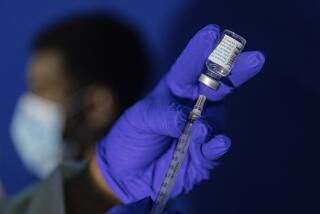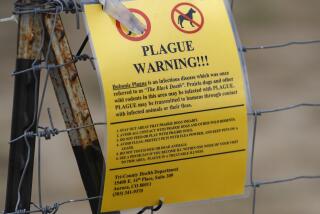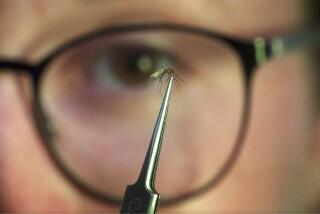World View : Deadly Malaria Comes Back With a Vengeance : The tropical disease rages through sub-Saharan Africa and parts of Asia and Latin America. In one Pacific capital, everyone is infected.
- Share via
HONIARA, Solomon Islands — It is a dubious distinction perhaps, but eager medical researchers from distant lands flock to this sleepy, southwest Pacific capital just to take blood samples from the citizens.
The reason: Honiara has the world’s highest recorded incidence of malaria, the single-celled, mosquito-borne parasite that has frustrated science for more than a century. Last year, in fact, Honiara achieved the seemingly impossible: Thanks to repeat cases, it registered 1,120 bouts of malaria for every 1,000 residents.
“Everyone in Honiara now has the parasite,” conceded Judson L. Leafasia, acting director and chief medical officer at the internationally funded Malaria Training and Research Institute here. “And it’s getting worse.”
More importantly, malaria has grown worse worldwide in the past decade, according to the World Health Organization. Indeed, United Nations statistics show it’s the only major disease other than AIDS that is steadily spreading today. More than 1 million people--mostly children under 5--die each year from a disease that is both curable and preventable.
Most malaria deaths are in sub-Saharan Africa, where drought and starvation lower resistance, control programs are lacking and there are few clinics or drugs to treat the victims. But the infection rate also has risen in scores of other tropical countries after a World Health Organization decision in 1969 to abandon a 20-year worldwide effort to eliminate the disease.
“It was realized eradication was not achievable,” said John Storey, malaria scientist at the U.N. agency’s Western Pacific regional headquarters in Manila. “So we switched emphasis to control.”
There was little choice. Despite some successes, both the parasite and the mosquitoes that carry it proved far hardier than expected. No anti-malaria vaccine corresponding to the vaccine against smallpox has been found--despite years of effort. And wholesale spraying of DDT, a powerful insecticide that wipes out malaria-carrying mosquitoes, was stopped due to environmental damage and high costs.
Once the spraying stopped, the disease came back with a vengeance. Today, malaria rages in parts of Asia and Latin America where “it had been considerably reduced or eliminated during the 1960s and 1970s,” reports World Health, the official WHO magazine. In Africa, “the situation is worsening all the time.”
Nearly half the world’s population, in 103 countries from Afghanistan to Zambia, is at risk from malaria. The World Health Organization estimates that 270 million people now carry the parasite, and 110 million suffer recurring flu-like attacks of aching bones, fiery fever, icy chills and worse. Cerebral or falciparum malaria, the most dangerous of four malaria parasites, can kill within hours.
Partly to focus attention on the growing problem, WHO will hold a global conference on malaria this October in Amsterdam. Dozens of health ministers are expected to adopt a worldwide control strategy.
Experts say malaria is worsening for several reasons.
New roads, logging and irrigation have drawn people into tropical jungles and other once-isolated areas where mosquitoes swarm. Refugees, migrants and tourists have spread the disease across borders. Urban drift, poverty and poor sanitation have returned it to cities where it once was eliminated.
And most worrisome, the foe is far stronger. In many areas, the Anopheles mosquito, which transmits malaria, is increasingly resistant to insecticides. Even worse, the malaria parasites are increasingly resistant to chloroquine, the drug most widely used for prophylaxis and treatment. New drug treatments are less effective and much more expensive.
In Cambodia, for example, a particularly virulent and drug-resistant strain of cerebral malaria threatens the U.N. peacekeeping forces, as well as several hundred thousand refugees awaiting repatriation. Although conditions vary from place to place, this parasite is now resistant to chloroquine, fanzidar, quinine and mefloquine, a powerful drug once used as a last resort.
“Though mines are killing perhaps two to four people a day, malaria is killing very many more,” said Dr. Jean-Paul Menu, the U.N. health agency’s representative in Cambodia.
U.N. troops are using doxycycline, a broad-spectrum antibiotic that so far appears effective. They also sleep under insecticide-doused nets, wear long sleeves and take other precautions.
Meanwhile, new drugs are being sought. The best hope is arteether, derived from an herb used to fight fevers for more than 2,000 years in China. WHO says it “may well be the most important natural extract” against malaria since quinine was isolated from cinchona bark in 1834. Field tests of arteether are under way or planned in Vietnam, Papua New Guinea, Kenya and Nigeria.
Part of the problem is that the unicelled malaria parasites, called plasmodia, lead complex lives. When an infected mosquito bites, it injects parasites into the bloodstream. The plasmodia lodge in the liver, where each soon multiplies 40,000 times. These in turn invade red blood cells, multiply again and so on, causing fever and chills.
In most cases, drugs can treat the disease. That’s why only 33 people died of malaria in the Solomon Islands last year, although nearly 42% of the 300,000 residents suffered from the disease. That’s nearly double the rate of four years ago.
Reasons for the increase are easy to find. Most DDT spraying stopped. Government raises cut into the health budget. Foreign aid money for supplies dried up. Fights between central and provincial health officials left a bureaucratic stalemate. The result was disaster.
“There was a cessation of all malaria control activities,” said Dr. Jayan Velayudhan, the WHO liaison officer in Honiara.
So Solomon Islanders make do. Health workers recently distributed 120 mosquito nets doused with permethrin, an insecticide, to residents in Vutu, a simple seaside village of thatched huts on wooden stilts about 12 miles north of Honiara.
But the nets are only partly effective. The coastal mosquito, Anopheles farauti, bites for two hours at dawn and again at dusk, precisely when villagers are cooking and drawing water outside.
“We have a hard time controlling it,” said Bernard Bakote, a government entomologist. “It’s a social problem. The people get together and gossip, and the farauti are very happy.”
Not so the people. Barnabus Bana, a 47-year-old farmer, had malaria three times last year. So did his wife and four of their seven children. Each time, they took chloroquine until the fevers and shivering had passed.
“I feel pain, aches all over,” he recalled, describing the disease. “My body is weak. Sometimes I vomit. Inside I’m hot, outside I’m cold.”
Now his 15-year-old son, Garnett, sleeps under a net in the early morning heat. Nearby, tacked to the porch wall, a faded poster shows a huge, bloodthirsty mosquito. “WANTED DEAD: Ms. Anopheline,” it reads. “Crime: Brought death and suffering to most Solomon Islanders.”
Reprise of Ancient Scourge The Problem: Malaria describes a group of parasitic blood diseases that have caused sickness and death since ancient times. The word derives from Italian, meaning “bad air.”
Transmission: The culprit is a microscopic, one-celled parasite of the genus Plasmodium that is passed from an infected person to an uninfected one through the bite of a female Anopheles mosquito.
Symptoms may include:
* repeated attacks of violent shaking and chills
* fever as high as 106 degrees F
* severe headaches
* profuse sweating
* enlargement of the spleen
* severe anemia
* muscular pain
* nausea
May occur in two- or three-day cycles, depending on which of four strains is involved.
Treatment: The drug chloroquine is the primary treatment. Certain strains also require primoquine to combat liver infections. Where the organism has become resistant to treatment with chloroquine, three drugs must be used together: quinine, pyrimethamine, and a sulfa drug. An infected mosquito injects Plasmodia with its bite.
Each Plasmodium invades a liver cell and multiplies.
The cell bursts, releasing a new form of Plasmodia.
Each Plasmodium enters a red blood cell and multiplies.
Cell ruptures, and Plasmodia invade more red cells.
Some Plasmodia are able to infect mosquitoes.
Prevention: * Take chloroquine before entering and for six weeks after leaving infected regions.
* Use insect repellent and mosquito netting to reduce the likelihood of being bitten by infected mosquitoes. * Spray with insecticides such as DDT and drain marshes and other areas of stagnant water where mosquitoes breed.
Reported malaria cases (in thousands) 1981-1988(1)
1981 1982 1983 1984 1985 1986 1987 Africa(2) 6,754 6,042 2,726 4,523 11,634 17,472 19,463 Americas 638 718 831 931 911 951 1,019 Eastern Mediterranean 207 308 305 335 391 610 565 Europe 60 66 73 62 57 47 28 South-East Asia 3,566 2,964 2,731 3,004 2,503 2,689 2,823 Western Pacific 3,464 2,487 1,839 1,410 1,178 1,012 893
1988 Africa(2) 21,957 Americas 1,120 Eastern Mediterranean 602 Europe 24 South-East Asia 2,789 Western Pacific 774
notes: 1 - The information provided is not complete in some instances.
2 - Figures for Africa are estimates because most countries do not have formal reporting systems in place.
Sources: World Health Organization, McGraw-Hill Encyclopedia of Science and Technology, World Book.
More to Read
Sign up for Essential California
The most important California stories and recommendations in your inbox every morning.
You may occasionally receive promotional content from the Los Angeles Times.














